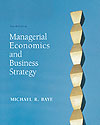This chapter develops the optimal choice for input procurement
and the principal-agent problem, as it relates to managerial compensation and
worker incentives. The manager must decide which inputs will be purchased from
other firms and which inputs the firm will manufacture itself. Spot exchange
generally is the most desirable alternative when there are many buyers and sellers
and low transaction costs associated with using a market. When market transaction costs are high and specific assets
are important, the manager may wish to purchase inputs from a specific supplier
using a contract or, alternatively forego the market entirely and have the firm
set up a subsidiary to produce the required input internally. In a relatively
simple contracting environment, a contract may be the most effective solution.
But, as the contracting environment becomes more complex and uncertain, internal
production through vertical integration becomes an attractive managerial strategy. The chapter also demonstrates a solution to the principal-agent
problem. Rewards must be constructed so as to induce the activities desired
of workers. For example, if all a manager wants from a worker is for the worker
to show up at the work place, an hourly wage rate and a time clock form an excellent
incentive scheme. If it is desirable to produce a high level of output with
very little emphasis on quality, piece-rate pay schemes work well. However,
if both quantity and quality of output are concerns, profit sharing is an excellent
motivator. |




 2002 McGraw-Hill Higher Education
2002 McGraw-Hill Higher Education